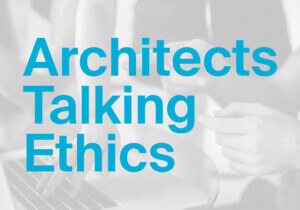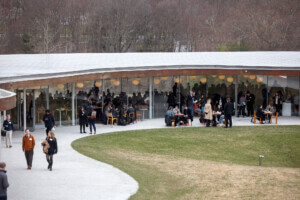The controversy over SCI-Arc’s “Basecamp: How to be in an Office” panel in late March remains stunning on so many levels, not the least being the students who have seen through SCI-Arc’s desire for hegemony over their academic and professional life. But the blatant display of that hegemony as it crosses from the academy to practice and back again is striking for perpetuating every single trope that keeps the discipline of architecture so weak while pretending to be so mighty.
The first trope—well, barely a trope since it is just bad facts—concerns the “economic” advice offered by panelists Marrikka Trotter, Margaret Griffin, and Dwayne Oyler to students in attendance. It went like this: When entering the profession, labor abuse is to be expected! Buckle up, don’t whine, and get a second job if you need to. The reward is the work itself. Life and work must be the same thing, or you’re not really “an architect.” Questioned about this advice, the panelists resorted to a series of undigested sub-tropes that cast denial on problems present in architectural work. On the question of how to handle not making a living wage, Griffin offered a practical response (in essence, if money is an issue, simply exit the profession), while Trotter, horrified by the talk about money, emphasized the importance of creativity and clout-building. On the question of what makes a good worker, the panelists exchanged inanities about hustling (Oyler advised that “You’ve got to have a side hustle and a side hustle to that side hustle”), entrepreneurial self-promotion, and personal sacrifice. In sum, the message to students was to accept, and to enjoy, their helplessness in the face of economic precarity.
The second trope proffered was less economically driven. This is the mystique of architectural education, which holds that academia is the locus of creativity, thence the locus of power. Because small, boutique offices function like school studios, they do real “creative” work, whereas big offices are for chumps. Another key difference: the boutique office, like the studio, functions as a “family” of likeminded designers. The sub-tropes to this rhetoric are pervasive. School is primarily about creativity, and skills such as knowing how to effectively engage nondisciplinary players—political, economic, and otherwise—are overlooked. Those who teach studio are golden, especially if they practice (literally, through their design office) what they preach. Students who get to work with instructors in both settings are the chosen ones. (It helps to adopt the cool aesthetics of the studio head, down to the black-on-black wardrobe.) By invoking the academia/work dichotomy, the Basecamp panelists sent a clear message to the students: something is wrong if you choose a work environment structured around said dichotomy.
The third trope, moving farther still from economics to ephemeral cultural assumptions, is the charm of the “creative subject.” Beyond the already recognized connection between creativity and sacrifice, and creativity and power, are images of the creative subject: white male iconoclast; individual genius; aesthetic avant-gardist; a-historical, a-political formalist; workaholic undeflected by family or community. These are all the things implicit in what the panel laid out for students, and it is worth tracing them through SCI-Arc’s institutional context. The school’s founding in Los Angeles in 1972 was spearheaded by Ray Kappe, who rejected the straight jackets imposed on architectural education at his former Department of Architecture at California Polytechnic State University at Pomona. SCI-Arc would counter this tendency by locating its agency outside the university and its bureaucratic regime. As a “college without walls,” it pursued horizontal relationships between faculty and students in lieu of traditional academic hierarchies. The subject it aimed to produce was autonomous and empowered to act in the real world. That its first graduates entered a ravaged economy with high rates of unemployment speaks to the idealism of this aim. In fairness, the elevation of the creative subject over the making, laboring subject, had less to do with SCI-Arc and more to do with 20th-century attitudes toward the aestheticized object. Still, we shouldn’t ignore SCI-Arc’s inbred hiring practices, which cull from the student body while looking askance at the uninitiated. In the end, the institutional walls didn’t go away; they got higher.
More on why these tropes are false later. For now, we might ask why the controversy surrounding the Basecamp panel took the form that it did. Many seemed genuinely surprised by the advice doled out by Trotter et al., or perhaps more by its blatantly garish tone. But this is precisely how capitalist ideology works. Its goal is aligned with SCI-Arc’s, i.e., to produce a precarious but passive subject open to exploitation. In case we need reminding, Louis Althusser’s 1969 essay “Ideology and the Ideological State Apparatus” is very clear on the work of ideology. Up until that time (and continuing to today), Marxists tended to prioritize the material conditions of the economy, called the “base,” over cultural norms and rituals, known as the “superstructure.” But Althusser observed that the superstructure is always performed in practical, economically determined, material acts. That closed loop—moving from the base (the material conditions that we are born into) to superstructure (the tropes we are taught) and back again (our performance/labor in the economy)—exists because it is absorbed into our subjectivity. We live it.
Given that so many aspects of Althusser’s observations haunt the SCI-Arc scenario, it is hard to resist quoting the text in its entirety. But specific lessons on various aspects of how ideology works in an educational context such as SCI-Arc can be examined. First, on ideology in general:
[A]ll ideology represents in its necessarily imaginary distortion not the existing relations of production (and the other relations that derive from them), but above all the (imaginary) relationship of individuals to the relations of production and the relations that derive from them. What is represented in ideology is therefore not the system of the real relations which govern the existence of individuals, but the imaginary relation of those individuals to the real relations in which they live.
In other words, ideology turns students away from the facts of their material existence—precarity—so they won’t recognize it as such.
You might wonder why individuals would willingly succumb to imaginary relations instead of real ones, but Althusser is clear that such succumbing isn’t “caused” by repressive forces external to the individual. Rather, it is the result of the system of institutions—schools, churches, legal and political systems, the family—into which the individual is thrust and must perform. Althusser’s Ideological State Apparatuses (ISAs) explain how it is that we think we are making choices in our best interests but are not actually “free” to do so. Students don’t want to be hoodwinked about the use of their labor, but ISAs make that abuse appear natural.
Of all the ISAs, though, schools are the primary culprit. “The mechanisms which produce this vital result for the capitalist regime are naturally covered up and concealed by a universally reigning ideology of the School, universally reigning because it is one of the essential forms of the ruling bourgeois ideology.” Elaborating, Althusser writes that the capacity of ideology to make the School seem like a neutral environment where “teachers respectful of the ‘conscience’ and ‘freedom’ of the children” open up for them the supposed to path to “liberating’ virtues.”
Althusser gets specific about the two identities that operate in the academy. “Somewhere around the age of 16, a huge mass of children are ejected ‘into production’: [a] portion of scholastically adapted youth carries on…[filling] the posts of small and middle technicians, white-collar workers, small and middle executives, petty bourgeois of all kinds.” This white-collar worker, he clarifies, is educated into competency. “[U]nlike social formations characterized by slavery or serfdom this reproduction of the skills of [white-collar] labour power…[are] achieved more and more outside production: by the capitalist education system, and by other instances and institutions.” Put simply, we can’t blame “practice” for architects’ precarity; schools do the indoctrination.
He also imagines the teacher’s role in subject formation and the limitations inherent to this relation:
I ask the pardon of those teachers who, in dreadful conditions, attempt to turn the few weapons they can find in the history and learning they “teach” against the ideology, the system and the practices in which they are trapped. They are a kind of hero. But they are rare and how many (the majority) do not even begin to suspect the “work” the system (which is bigger than they are and crushes them) forces them to do, or worse, put all their heart and ingenuity into performing it with the most advanced awareness (the famous new methods!). So little do they suspect it that their own devotion contributes to the maintenance and nourishment of this ideological representation of the School, which makes the School today as “natural,” indispensable-useful and even beneficial for our contemporaries as the Church was “natural,” indispensable and generous for our ancestors a few centuries ago.
If productive competency is ideologically instilled through education, ideology is manifest in material acts, acts that are neither more nor less than subjectivity itself. The “existence of the ideas of [the subject’s] belief,” Althusser writes, “is material in that his ideas are his material actions inserted into material practices governed by material rituals … from which derive the ideas of that subject.” We “volunteer” for these acts because we feel ourselves to be “hailed” (Althusser’s word) by the siren call of ideological exceptionalism. I think all of us architects have heard the siren to perform the “calling” of our beautiful and very public acts. SCI-Arc’s Basecamp was merely making that “hail” overt.
Whether or not one agrees with the strength or evil of ideology as described by Althusser, one can’t help recognizing in his text the attitudes of the Basecamp panelists. In this, one has to also recognize that SCI-Arc is merely the most blatant example of the role architecture schools everywhere play in preparing us to be willing, precarious workers. Perhaps its very blatantness has led students to finally break through the haze of ideological mystique. (In the wake of the panel, Trotter, who is SCI-Arc’s history and theory coordinator, and Tom Wiscombe, chair of its undergraduate program, were placed on administrative leave following accusations made by students; they allege that they endured toxic labor practices while interning at Wiscombe’s namesake studio, where Trotter also works.)
We can return now to addressing the false and bad advice for “how to be in an office.” Here, I offer my own “base”-camp teachings. They are informed by Althusser’s observations to the extent that they deal with the “base” of a student’s material condition by acknowledging the role of the “superstructure.” But such teachings also draw on decades of personal experience in academia, where I watched former students getting lost in a profession that told them false stories about their worth. Told by studio critics that passion and talent would bring cultural fame and social empowerment, they ended up flailing in their careers, unable to find a rich patron who would let them design their weekend home. (Their instructors had done it! Why couldn’t they?)
In lieu of the Basecamp tips, the following are, I believe, more urgent, succinct, and operative bits of advice for those heading into the profession:
1. Saying that if an architectural worker doesn’t like their labor conditions they should just go elsewhere is like saying to children working in 19th-century factories that if they didn’t like it, they didn’t have to come to work.
2. Any firm owner who doesn’t understand the value and cost of labor doesn’t have a business plan. Any firm that doesn’t have a business plan is irrelevant to our economy and hence irrelevant to systems of power. (Why should architects be shocked that the public doesn’t value and pay for our work when we don’t ourselves?) And the architect who requires unpaid labor to complete a project doesn’t have a project.
3. If we don’t see architectural work as part of the economy, we shouldn’t be surprised that the economy does architects no favors.
4. Heed the advice given by Slavoj Žižek: The biggest gift that an employer can give to an employee is making clear the fundamental difference in their status; the latter is always at the mercy of the former. Any firm describing itself as a “family” or a “team” ensures you’ll feel uncomfortable asking for a raise.
5. Don’t confuse the liberalism of “avant-garde” design studios or “progressive” firms with actual leftist politics, which is by definition pro-worker.
6. Life equals work only in slavery.
7. Don’t work for your studio critic.
8. Don’t let management tell you—labor—what labor should look like.
Peggy Deamer is Professor Emerita of Yale University’s School of Architecture, principal of Deamer, Studio and the founding member of the Architecture Lobby, a group advocating for the value of architectural labor. She is the editor of Architecture and Capitalism: 1845 to the Present and The Architect as Worker: Immaterial Labor, the Creative Class, and the Politics of Design and the author of Architecture and Labor.











